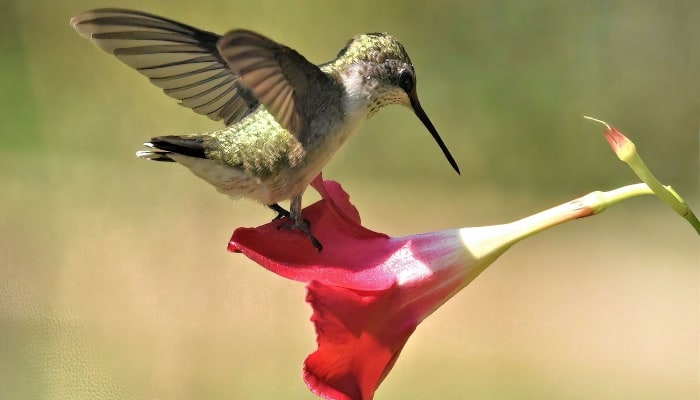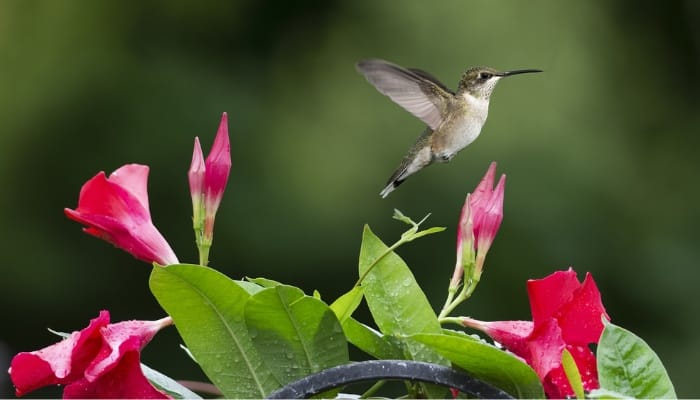The Mandevilla genus is recognized for its densely leafed vines that produce trumpet-shaped flowers in shades of pink, red, and white.
It is also commonly known as rocktrumpet and grows naturally in subtropical and tropical climates. With its large flowers, you may be asking if it is good at attracting pollinators, more specifically — hummingbirds!
Does Mandevilla attract hummingbirds? Mandevilla plants have trumpet-shaped flowers that are great for hummingbirds to feed from. They have brightly colored flowers that produce a sweet fragrance when the blooms open. The flowers also provide plentiful nectar that hummingbirds need as a food source to live.
While the many Mandevilla species attract hummingbirds, they also attract other pollinators as well.
Read on to understand why hummingbirds enjoy visiting the flowers, other pollinators Mandevilla attracts, and how to attract even more pollinators to your garden.
Mandevilla and Pollinators – What To Know
Pollinators will only visit a flower if it offers them something in return. Mandevilla’s bright pink, red, and white flowers entice them while the sweet nectar and fragrance bring them in for a taste.
They will then subsequently take pollen from those flowers to other plants, helping to drive pollination and diversity.
Does Mandevilla Produce Nectar?
All Mandevilla species produce nectar to attract pollinators. The nectar is located at the bottom of their tube-shaped blooms, making hummingbirds a perfectly suited species to visit with their specialized beaks.
Does Mandevilla Smell Good?
Many Mandevilla species will smell good to pollinators, enticing them to stop by. However, some species may produce no fragrance, and others will produce a strong scent.
If you’re looking to plant a variety that will produce strong heavenly-smelling blooms, plant Chilean Mandevilla (Mandevilla laxa) for a vanilla-smelling treat whenever it blooms.
Do Mandevilla Plants Attract Bees?
Bees are sure to stop by your Mandevilla for a meal! They will gather pollen while climbing deep within the flower to reach its nectar and transport it around to other flowering species, thus helping the native ecosystem.
Does Mandevilla Attract Butterflies?
The various Mandevilla species are great at attracting all pollinators with their nectar, fragrance, and bright-colored flowers.
Butterflies will enjoy stopping by to taste most varieties of Mandevilla while Mandevilla tenuifolia has evolved to only be pollinated by butterflies.
Are Hummingbirds Attracted to Mandevilla?
Hummingbirds are a perfect pollinating companion to Mandevilla because of their modified beaks, which enable them to reach into the trumpet-shaped flower to feed on the nectar.
They are mainly attracted to the red and pink flower colors that entice them to stop by.
Other Pollinators Attracted to Mandevilla
With the sweet nectar Mandevilla offers, species in this family are also regularly pollinated by flies, beetles, ants, wasps, and hornet species.
While many insects are not considered pollinators, most are attracted to the sweet nectar that flowers provide.
With even just one visit to a flower, an insect may end up carrying pollen to another flower, in turn making them a pollinator!
What Mandevilla Colors Are Best for Attracting Pollinators?
Most of the colors Mandevilla plants bloom in are great at attracting pollinators. In terms of hummingbirds, the red and pink flowers entice them the most.
Bees prefer all bright-colored flowers, and most other pollinators will stop by for the scent, no matter the color.

What Are Hummingbirds Attracted To?
Hummingbirds are mainly attracted to flowers since their main food source of nectar is found within them.
They must consume copious amounts of nectar to support their fast metabolism and busy schedule. Hummingbirds are mostly attracted to bright red and pink flowers with sweet nectar.
Are Hummingbirds Pollinators?
While most people look at hummingbirds more as birds than pollinators, they visit countless species of flowers collecting nectar as a food source for their high-energy needs.
As they visit each flower, they will also collect pollen on their beak and feathers, transporting it around to other flower species.
How To Attract More Hummingbirds
The best way to attract hummingbirds is by planting species that provide nectar for them. Their main food source is nectar, and their main objective each day is to find enough to survive.
Adding a water feature will give them a place to drink and bathe. Plant varieties like hummingbird sage and trumpet honeysuckle to attract species to your yard.
How To Attract Bees to Your Garden
Bees are nature’s most vital pollinator, and attracting them to your yard not only helps with your garden’s health but also the world’s!
Plant native flowers as these usually attract bees the best, and offer plentiful pollen and nectar for them. Bee balm, clover, and dandelions are some of the bee’s favorites.
If you’re really into pollinators, think about adding a bee hive to your backyard.
Many times a local organization will trade you fresh honey for a place to keep their bees while you don’t have to do any of the work!
The Bee Conservancy is a great place to learn more about the importance of bees and how you can help to strengthen their species!
Related Questions:
Do Hummingbirds Like Dipladenia?
Mandevilla and Dipladenia are in the same family and have many of the same care requirements, and they are both loved by hummingbirds and pollinators.
It is usually found that hummingbirds prefer Dipladenia over Mandevilla for it blooms from spring through fall.
Why Do Hummingbirds Like Red?
You may have noticed that most hummingbird feeders are red or that the little birds always seem to prefer the red flowers in your garden.
It has been found that hummingbird eyes function with a filter for red and yellow while muting colors like blue and purple since the color red in flowers is usually associated with high levels of nectar, the sugars they need to produce energy.
Conclusion
Hummingbirds are always a treat to see in your garden, and varieties of Mandevilla are sure to bring them to your garden.
Mandevilla vines will also attract other pollinators as well, so they make a great addition that is also helpful to the native ecosystem.
Plant other species around to attract numerous other beneficial insects, and your garden will be full of life before you know it!

